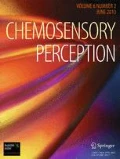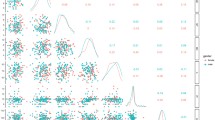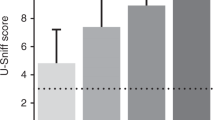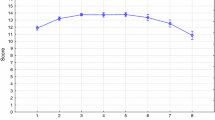Abstract
Introduction
A great degree of interindividual variability has been reported in measures of psychophysical olfactory performance and odor awareness in both children and adults. Previous studies have suggested the possibility that one of the factors that might contribute to this variability could be the degree of odor exposure experienced in everyday contexts.
Aim
In the present study, we hypothesized that children exposed to a greater variety of odors on a more frequent basis exhibit higher odor identification, discrimination, and odor awareness scores.
Results
We have found an effect of odor exposure on one aspect of the children’s olfactory knowledge as reflected in their reports of olfactory behavior, but not olfactory abilities. In so doing, we have replicated some of the previous findings in the literature of the female advantage in the olfactory domain. Namely, we report that girls showed a more profound metacognitive understanding of their sense of smell and a greater degree of olfaction-oriented behavior, which was not accounted for by a gender difference in verbal fluency. Nevertheless, girls did not outperform boys on any of the olfactory tests.
Conclusion
Semi-longitudinal and longitudinal studies in verbally proficient children, employing both self- and parental reports of children’s odor exposure and repeated olfactory testing, may provide insight into whether children exposed more frequently to a greater variety of odors over the longer term come to exhibit greater odor awareness and superior performance in olfactory tests.
Similar content being viewed by others
References
Arshamian A, Willander J, Larsson M (2011) Olfactory awareness is positively associated to odour memory. J Cogn Psychol 23:220–226
Bastos LOD, Mantovani Guerreiro M, Lees AJ et al (2015) Effects of age and cognition on a cross-cultural paediatric adaptation of the Sniffin’ sticks identification test. PLoS ONE 10:e0131641
Bianchi SM, Milkie MA, Sayer LC et al (2000) Is anyone doing the housework? Trends in the gender division of household labor. Soc Forces 79:191–228
Brand G, Millot JL (2001) Sex differences in human olfaction: between evidence and enigma. Q J Exp Psychol B Comp Physiol Psychol 54:259–270
Brocki KC, Bohlin G (2004) Executive functions in children aged 6 to 13: a dimensional and developmental study. Dev Neuropsychol 26:571–593
Buron E, Bulbena A, Pailhez G et al (2011) The Spanish version of two olfactory scales: reliability and validity. Rev Psiquiatr Salud Ment 4:187–194
Cameron EL, Doty RL (2013) Odor identification testing in children and young adults using the smell wheel. Int J Pediatr Otorhinolaryngol 77:346–350
Cohen JE (1988) Statistical power analysis for the behavioral sciences. Lawrence Erlbaum Associates, Inc., Hillsdale
Coltrane S (2000) Research on household labor: modeling and measuring the social embeddedness of routine family work. J Marriage Fam 62:1208–1233
Dematte ML, Endrizzi I, Biasioli F et al (2011) Individual variability in the awareness of odors: demographic parameters and odor identification ability. Chemosens Percept 4:175–185
Doty RL (1992) Psychophysical measurement of odor perception in human. In: Laing DG, Doty RL, Breipohl W (eds) The human sense of smell. Springer Verlag, Berlin, pp 1–40
Dudova I, Vodicka J, Havlovicova M et al (2011) Odor detection threshold, but not odor identification, is impaired in children with autism. Eur Child Adolesc Psychiatry 20:333–340
Ferdenzi C (2007) Variations interindividuelles des comportements olfactifs chez les enfants de 6–12 ans. Université de Bourgogne
Ferdenzi C, Coureaud G, Camos V et al (2008a) Human awareness and uses of odor cues in everyday life: results from a questionnaire study in children. Int J Behav Dev 32:422–431
Ferdenzi C, Mustonen S, Tuorila H et al (2008b) Children’s awareness and uses of odor cues in everyday life: a Finland-France comparison. Chemosens Percept 1:190–198
Ferguson CJ (2009) An effect size primer: a guide for clinicians and researchers. Prof Psychol Res Pract 40:532–538
Field A (2005) Discovering statistics using SPSS. Sage, London
Field A (2013) Discovering statistics using IBM SPSS statistics. Sage, London
Fuwa M, Cohen PN (2007) Housework and social policy. Soc Sci Res 36:512–530
Groot AS, de Sonneville LMJ, Stins JF et al (2004) Familial influences on sustained attention and inhibition in preschoolers. J Child Psychol Psychiatry 45:306–314
Haun DBM, Tomasello M (2011) Conformity to peer pressure in preschool children. Child Dev 82:1759–1767
Hrdlicka M, Vodicka J, Havlovicova M et al (2011) Brief report: significant differences in perceived odor pleasantness found in children with ASD. J Autism Dev Disord 41:524–527
Hummel T, Bensafi M, Nikolaus J et al (2007a) Olfactory function in children assessed with psychophysical and electrophysiological techniques. Behav Brain Res 180:133–138
Hummel T, Kobal G, Gudziol H et al (2007b) Normative data for the “Sniffin’ Sticks” including tests of odor identification, odor discrimination, and olfactory thresholds: an upgrade based on a group of more than 3,000 subjects. Eur Arch Otorhinolaryngol 264:237–243
Hummel T, Sekinger B, Wolf SR et al (1997) “Sniffin’ Sticks”: olfactory performance assessed by the combined testing of odor identification, odor discrimination and olfactory threshold. Chem Senses 22:39–52
Hummel T, Smitka M, Puschmann S et al (2011) Correlation between olfactory bulb volume and olfactory function in children and adolescents. Exp Brain Res 214:285–291
Konstantinidis I, Triaridis S, Triaridis A et al (2005) How do children with adenoid hypertrophy smell and taste?—Clinical assessment of olfactory function pre- and post-adenoidectomy. Int J Pediatr Otorhinolaryngol 69:1343–1349
Larsson M, Finkel D, Pedersen NL (2000) Odor identification: influences of age, gender, cognition, and personality. J Gerontol B Psychol Sci Soc Sci 55:304–310
MacPhee M (1992) Deodorized culture: anthropology of smell in America. Arizona Anthropol 8:89–102
Martinec Nováková L, Plotěná D, Roberts SC et al (2015) Positive relationship between odor identification and affective responses of negatively valenced odors. Front Psychol 6:607
Monnery-Patris S, Rouby C, Nicklaus S et al (2009) Development of olfactory ability in children: sensitivity and identification. Dev Psychobiol 51:268–276
Nigg JT, Quamma JP, Greenberg MT et al (1999) A two-year longitudinal study of neuropsychological and cognitive performance in relation to behavioral problems and competencies in elementary school children. J Abnorm Child Psychol 27:51–63
Nováková L, Valentova JV, Havlíček J (2014) Engagement in olfaction-related activities is associated with the ability of odor identification and odor awareness. Chemosens Percept 7:56–67
Pascualvaca DM, Anthony BJ, Arnold LE et al (1997) Attention performance in an epidemiological sample of urban children: the role of gender and verbal intelligence. Child Neuropsychol 3:13–27
Poulin-Dubois D, Serbin LA, Eichstedt JA et al (2002) Men don’t put on make-up: Toddlers’ knowledge of the gender stereotyping of household activities. Soc Dev 11:166–181
Preiss M (1997) Verbální fluence, metoda vyšetření poškození mozku u dětí a dospělých. Cesk Psychol 41:244–249
Renner B, Mueller CA, Dreier J et al (2009) The candy smell test: a new test for retronasal olfactory performance. Laryngoscope 119:487–495
Riggs NR, Blair CB, Greenberg MT (2003) Concurrent and 2-year longitudinal relations between executive function and the behavior of 1st and 2nd grade children. Child Neuropsychol 9:267–276
Richman RA, Post EM, Sheehe PR et al (1992) Olfactory performance during childhood. I Development of an odorant identification test for children. J Pediatr 121:908–911
Romanos M, Renner TJ, Schecklmann M et al (2008) Improved odor sensitivity in attention-deficit/hyperactivity disorder. Biol Psychiatry 64:938–940
Rosenthal R (1994) Parametric measures of effect size. In: Cooper H, Hedges LV (eds) The handbook of research synthesis. Sage, New York, NY, pp 231–244
Saxton TK, Martinec Nováková L, Jash R et al (2014) Sex differences in olfactory behavior in Namibian and Czech children. Chemosens Percept 7:117–125
Schriever VA, Mori E, Petters W et al (2014) The “Sniffin’ kids” test— a 14-item odor identification test for children. PLoS ONE 9:e101086
Smeets MAM, Schifferstein HNJ, Boelema SR et al (2008) The Odor Awareness Scale: a new scale for measuring positive and negative odor awareness. Chem Senses 33:725–734
Sorokowska A, Schriever VA, Gudziol V et al (2015) Changes of olfactory abilities in relation to age: odor identification in more than 1400 people aged 4 to 80 years. Eur Arch Otorhinolaryngol 272:1937–1944
Stevens JP (2009) Applied multivariate statistics for the social sciences. Routledge, London
Sucker K, Berresheim H, Ramcke-Krüll H et al (2010) Approach to characterize a sub-group susceptible to odour annoyance. Chem Eng Trans 23:99–104
Walker DA (2003) JMASM9: converting Kendall’s tau for correlational or meta-analytic analyses. J Mod Appl Stat Methods 2:525–530
Acknowledgments
The authors would like to express their gratitude to Camille Ferdenzi for providing them with the Olfactory Diversity Questionnaire (ODQ) and its translation from French to English, and Anna Šandová and Jan Havlíček for providing them with the Czech translation of the Children’s Olfactory Behaviors in Everyday Life Questionnaire (COBEL). We are very grateful to the children and their parents for their participation, and school principals and teachers for allowing us to perform the study in school premises. We would also like to thank the three reviewers for their constructive feedback.
Author information
Authors and Affiliations
Corresponding author
Ethics declarations
Funding
This publication was supported by the project “National Institute of Mental Health (NIMH-CZ)”, grant number ED2.1.00/03.0078 and the European Regional Development Fund, the Ministry of Education, Youth and Sports—Institutional Support for Longterm Development of Research Organizations—Charles University, Faculty of Humanities (PRVOUK P20) and has been funded as part of the Specific Academic Research project (SVV) 2015 and 2016 numbers 260 239 and 260 348, respectively. LMN is supported by the Charles University Research Centre (UNCE 204004).
Conflict of Interest
The authors declare that they have no conflict of interest.
Ethical Approval
Details of institutional ethical approval for the research, and ethical procedures followed, are given in the “Participants” section.
Rights and permissions
About this article
Cite this article
Martinec Nováková, L., Vojtušová Mrzílková, R. Children’s exposure to odors in everyday contexts predicts their odor awareness. Chem. Percept. 9, 56–68 (2016). https://doi.org/10.1007/s12078-016-9205-3
Received:
Accepted:
Published:
Issue Date:
DOI: https://doi.org/10.1007/s12078-016-9205-3




